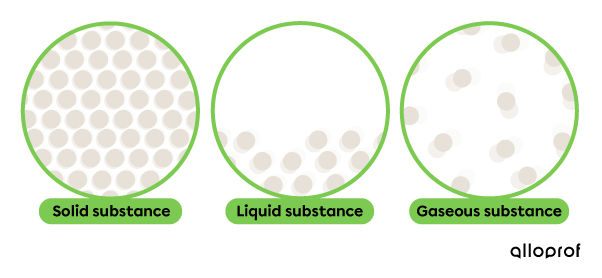Temperature is a measure of the degree of agitation of particles (atoms or molecules).
Temperature is a non-characteristic property of matter. An object may appear inanimate to the naked eye, but the particles that make up the object are not. They move quickly and continuously inside an object. It is called thermal agitation.
When heat is applied to a substance, its particles agitate more and its temperature rises. So, the more the agitation of particles, the higher the substance’s temperature. By contrast, the less the agitation of particles, the lower the temperature.
The agitation of particles varies depending on the state of matter. According to the particle model, particles of a solid vibrate slowly in place. Particles of a liquid vibrate more quickly and slide all over each other. Particles of a gas, however, vibrate very fast and move very quickly in all directions.

There are characteristic properties that are linked to temperature such as the melting point and boiling point.
The thermometer is an instrument for measuring temperature.
The units of measurement for temperature are degrees Celsius |(°\text{C}),| degrees Fahrenheit |(°\text{F})| and Kelvin |(\text{K}).| It is more common to use degrees Celsius in Canada, while degrees Fahrenheit are used in the United States. The Kelvin scale is used by scientists all over the world.
It is common practice in Quebec to use degrees Fahrenheit for cooking and baking, as well as determining the temperature of a pool.

New Africa, Shutterstock.com

ericlefrancais, Shutterstock.com
The freezing point and boiling point of water are |0\ °\text{C}| and |100\ °\text{C},| respectively. In Fahrenheit, the equivalent temperatures are |32\ °\text{F}| and |212\ °\text{F}.|
A change of |1\ °\text{F}| is equal to a change of |0.556\ °\text{C}.|
The following is how to convert from degrees Celsius to degrees Fahrenheit.
|°\text{C}=(°\text{F}-32) \times \dfrac{5}{9}|
There are many types of thermometers. The one that is most commonly used in high schools is the alcohol thermometer.
The following are different types of thermometers that can be used depending on the situation for everyday, scientific or medical use.

The alcohol thermometer uses the principle of thermal expansion to measure the temperature of a substance. A column of alcohol dilates or contracts in a graduated glass capillary tube.
Once the thermometer touches a substance with a different temperature, an exchange of heat occurs.
A hotter substance transfers some of its heat to the thermometer. The alcohol dilates in the glass capillary tube and indicates a higher temperature.
By contrast, a cooler substance absorbs part of the thermometer's heat. Since the alcohol is deprived of some of its heat, it contracts in the glass capillary tube and indicates a lower temperature.

In the past, thermometers were made with mercury instead of alcohol. Mercury is a heavy metal that is toxic to humans and the environment (the reason why it is no longer used today). When using a mercury thermometer, we have to be careful. If it breaks during use, the mercury must not be touched.
Also, it’s not safe to throw the debris in the garbage, the sink or the toilet. A mercury thermometer must be either discarded during a hazardous waste pick up or taken to a local ecocentre.